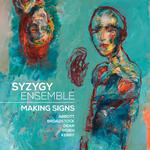Selected products featuring this work — Display all products (1 more)

$POA

This item may be available to purchase from the Australian Music Centre.
Please contact our Sales Department to confirm pricing and availability.
Display all products featuring this work (1 more) ![]()
Work Overview
Of the three subjects of the Trivium, Grammar was possibly the most challenging as the basis for a piece of music. It would be easy enough to have been self-consciously rhetorical, or to fashion a highly systematised, and therefore logical, work. But what of grammar? Sister Miriam Joseph, in her excellent book, The Trivium, writes of grammar as 'the art of inventing and combining symbols', and goes on to explain that logic is concerned with 'the thing-as-it-is-known', rhetoric with the 'thing-as-it-is-communicated', and grammar with the 'thing-as-it-is-symbolised'. But is there a 'thing' that can be known, symbolised and communicated through music, and if so, what it is? It's an ancient debate: the poet Auden, describing artists wrote that 'All the others translate'; but of the composer, he said, 'Only your notes are pure contraption/only your song is an absolute gift'. But, musing, I remembered, from the various works of French theory that were de rigeur (see what I did there?) in my student days, the words of Claude Lévi-Strauss to the effect that 'music is a language that does not signify'. Elsewhere, he divides composers into three groups, each of which is primarily, though not only, concerned with 'code' (for instance Bach or Stravinsky), 'message' (Beethoven, Ravel) or 'myth' (Wagner, Debussy). I have no idea where I fit in.
Making Signs has no extramusical program. In one movement it begins with a fragment of melody featuring the cello, which introduces and later, on violin, interrupts a much more active texture of rapid passage work. A slower section fragments a series of simple chords, diverts into some even simpler counterpoint, briefly recalls the opening harmony and concludes with a mosaic of repeated figures that fade to nothing.
Work Details
Year: 2014
Instrumentation: Flute, clarinet, piano, violin, cello.
Duration: 11 min.
Difficulty: Advanced
Dedication note: Dedicated to Kate Durham, Julian Burnside
Commission note: Commissioned by Julian Burnside, Australian Cultural Fund for performance by Syzygy Ensemble.
First performance: by Syzygy Ensemble at Syzygy Ensemble: Grammar (Melbourne Recital Centre, Primrose Potter Salon) on 18 Sep 2014
Performances of this work
4 Sep 2016: at Music in the Round (Abbotsford Convent). Featuring Syzygy Ensemble.
19 Jun 2016: at Syzygy Ensemble debut album tour (Glebe Justice Centre). Featuring Syzygy Ensemble.
5 Jun 2016: at Syzygy Ensemble debut album tour (Pilgrim Church). Featuring Syzygy Ensemble.
18 Sep 2014: at Syzygy Ensemble: Grammar (Melbourne Recital Centre, Primrose Potter Salon). Featuring Syzygy Ensemble.
User reviews
Be the first to share your thoughts, opinions and insights about this work.
To post a comment please login.

